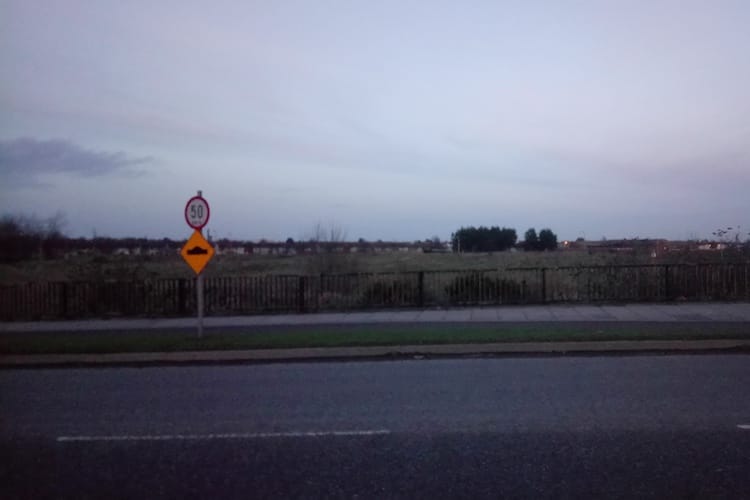What would become of the Civic Offices on Wood Quay if the council relocates?
After The Currency reported the idea of the council moving its HQ, councillors were talking about and thinking through the pros and cons and implications.
The council has started to work on a new local area plan for the neighbourhood.

If the empty lands in Cherry Orchard and Park West were fully developed, they could fit as many as 2,000 new homes in the western neighbourhood – and a new village centre.
Dublin City Council has started work on a new local area plan, and is expected to kick off the process of asking locals what they think in the coming weeks.
Senior Executive Planner Fiona Cooper sketched out its current vision at last Wednesday’s meeting of the council’s South Central Area Committee.
That includes a main street and civic centre, as well as a new supermarket, integrated public transport, and a new road to link the area to the Ballyfermot Road and to the Luas.
The early debate around the plan for the neighbourhood has focused on how many homes should be built on the vacant land, whether 2,000 is too much, and whether amenities need to come first.
It takes about seven minutes on the train from Heuston Station to the Park West and Cherry Orchard train station. One of empty sites is right next to the station.
While the figure of 2,000 homes is drawn from the Dublin City Development Plan (2016-2022), which councillors wrote, not all councillors seemed to think that number is a good idea.
“It must be said before the rumour mill kicks in, there is no way the council will build 2,000 houses there,” said Sinn Féin Councillor Daithí Doolan, who chairs the council’s housing committee.
“It’s a low-density area […]. I certainly would argue against it at this stage,” he said at the meeting. Later, he said he didn’t think that number would be sustainable.
City Planner John O’Hara didn’t seem so certain at the meeting. “I don’t know about Councillor Doolan’s idea of predetermining density outputs, but we will listen to all aspects as we go through the process,” he said.
It’s unclear what kind of housing might be built in the neighbourhood – and who might build it. In the past, private developers have shown little interest.
In mid-2015, Dublin City Council officials asked developers what council land they would be interested in building on, a discussion that has since evolved into its “lands initiative”. At the time, private developers dismissed Cherry Orchard.
Doolan said he would like the council to build hundreds of affordable homes on the sites, homes for those who are above the threshold for social housing, but who can’t afford the high prices in Dublin’s private housing market. He said that he wants to see more social housing built in Cherry Orchard, too.
But he says he wants the plan that is put in place to be realistic, and for the estate to be completed. “Big open sites of undeveloped land could attract anti-social behaviour,” he says.
Fianna Fáil Councillor Daithí De Róiste, who is from Cherry Orchard, also said that the figure of up to 2,000 homes is “ludicrous”.

On Paper, or Beyond
Local area plans (LAPs) are blueprints for what should go where, when neighbourhoods are built on or up. Councillors vote them in. Developers have to conform to them.
In this case, though, the council owns almost half of the vacant land in Cherry Orchard and Park West.
That means it has the capacity to deliver on the plan itself, said Cooper. “It is not like doing an LAP just to guide a developer, it is doing an LAP to guide ourselves.”
There is already a social and community development plan for the area, said Cooper. This LAP should complement that.
That social plan outlines the need for a village centre as well as a community and social-enterprise hub in Cherry Orchard.
Those need to come first, says People Before Profit Councillor Hazel De Nortúin. Those who live there need a post office, schools, and shops, she says.
She would like to see a hub for people who are starting small businesses or social enterprises. And a community café too, perhaps linked to the community gardens.
This is the fourth council plan for the area, and this time it should focus on delivering services to the existing residents, she says.
“There are already ample houses there for them to put in place what they have promised,” she says. “The services should be there already.”
De Róiste of Fianna Fáil said the same. “We need more houses on council-owned land, but it must be sustainable development,” he says. “Problems will simply be further compounded by putting houses on top of houses.”
At the moment, the local school is “bursting at the seams”, there is no GP service in the area and the Gardaí in Ballyfermot are already over-stretched, says De Róiste.
“They keep coming back building houses, and they seem to forget about the post office and the newsagents and the doctor’s surgery that never comes with it,” he said.
It has to be different this time. “There needs to be an economic centre for Cherry Orchard if there is to be any success,” he says.
The council is expected to do a first round of public consultation in February and March this year. Planners hope to have a draft LAP complete with environmental reports by July 2018.
The draft should be available to the public to view in August and September, following a further round of public consultation. In November 2018, they intend to bring the plan before a meeting of the city council for a decision.